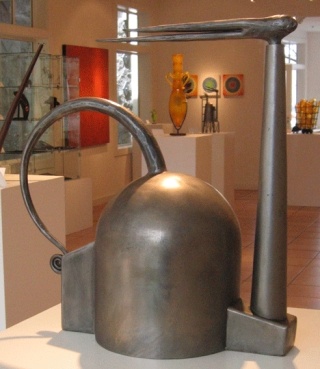When given a chance, people do extraordinary things.
One local artist assimilates that idea into one of the pieces in a series of blown glass and metal sculptures he created for MUSEO.
But beyond that concept, many of the pieces in the show are extraordinary in themselves.
Showing through the end of the month at the downtown Langley gallery is new work by artist David Gignac.
Some of the City-of-Big-Shoulders-like steel structures Gignac creates are in stark contrast to the colorful and delicate glass vessels to which he marries them, while others find a delicateness in steel equal to that of the glass.
Gignac actually names one piece “When Given a Chance,” with the idea that the metal vine growing out of a small plate over the heart of the slim, sunny glass urn is reflective of what one can do if the heart is open to possibility.
People can go through life with a built-up protection around their hearts, the artist said.
“The idea that they could let things grow there and follow that path, that let’s them peel back that protection; that’s where the vines grow,” he added.
The show reveals an artist who has a respect for common objects and their transformation to something unique, but remain familiar in some way.
“Notions occur to me while I’m creating a piece,” Gignac.
“Being a fan of surrealism, I see the mystery of objects. I create objects with enhanced life.”
Indeed, besides the urn with a heart and vine, is a forged truck with its back end made of a beautifully engineered cage full of rich yellow urns of varying sizes ntitled “Delivery Truck.”
Also, in the show is “Flat Bed Train Car with Tinanja,” a movable steel flat bed train car carrying an exquisitely graceful purple vessel that looks as though it was touched by the deepest recesses of the sea. Such pieces pull the viewer in through the familiarity of the vehicle to a netherworld of mysteries. It creates a startling effect.
“I don’t expect people to get all my meanings and messages,” Gignac said.
“But they may get things I may have not intended, too.”
It’s an ongoing exploration and Gignac said he is keenly aware of human nature and the tendency to collect stuff. Thus “stuff” — the objects that are apart of everyday life — become an inspiration.
“The trucks and trains represent the quantity of things we collect and the fact that these things need to be hauled.”
The glass vessels, he added, are the human element.
With all of the work, Gignac said, he strives to keep it accessible.
Accessibility comes to mind when looking at the steel teapots or spouted vessels he’s created, a signature object of the artist.
Gignac manages to steam up some sensuality from the polished steel of “Nuke IV,” a teapot-looking sculpture that combines smoothness, curves, angles, points, verticals, horizontals and some whimsical twists all in one piece. It looks like no teapot you’ve ever seen, yet still reminds one of home.
All of the teapots are playful and fun, yet Gignac manages to make each one completely different from the next.
Gignac’s work is unique but recognizable.
“I’ve developed a vocabulary of choices for myself and that has allowed me to create an identity in the work,” he said.
Gignac has had a number of shows at MUSEO since 1995. His work has also been shown at the Edge Gallery in Sante Fe, N.M. and is also currently at the Patricia Rovzar Gallery in Seattle.
At MUSEO, Gignac’s work is complemented by the paintings of Michael Hoffman, the other half of the current MUSEO show that runs until the end of May. Go see the mysteries.


